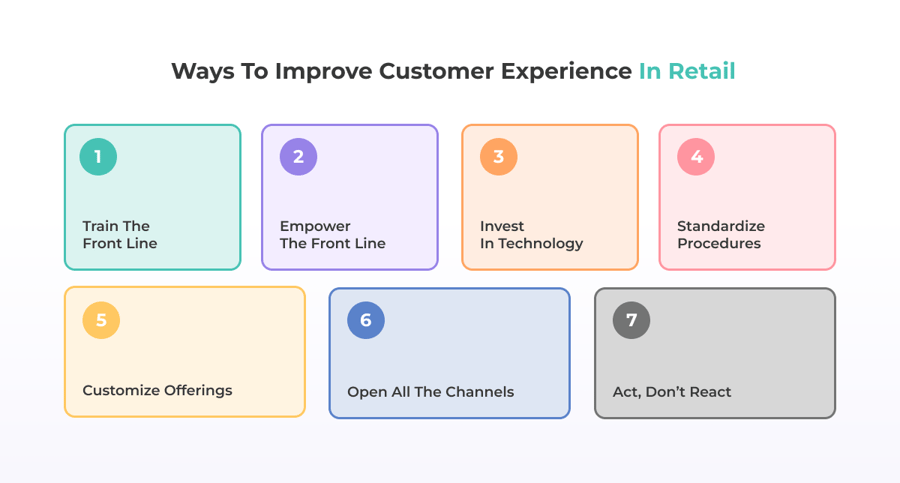Customer service will make or break your business, especially over the long term. This is not hyperbole. In consumers’ eyes (and wallets!), exceptional customer service in retail elevates your business above your less service-oriented competitors. It keeps those consumers returning again and again to your online or brick-and-mortar shop(s)—and keeps them from defecting to your competitors’ stores.
Retailers today must consider every interaction an opportunity to deliver the retail service that customers imagine they deserve. Those interactions include when your retail customers are navigating a store or website, encountering sales personnel face-to-face, engaging with an (actual or virtual) agent over the phone, via email, live chat, or social media, availing themselves of self-service, and in umpteen other ways.
Brand Loyalty Withers in the Glare of Poor Retail Customer Service
Seventy percent of surveyed consumers say they will quit a brand after just two bad experiences, and 24 percent will walk after only a single bad retail customer service experience, as reported in Chain Store Age. A “bad” experience could be as minor as being transferred and put on hold after, say, encountering a billing agent who doesn’t have the authority to reverse a mistaken charge. And once gone, these “disloyal” consumers rarely come back. This is a customer service in retail industry whether you're running a small boutique or managing a large retail chain.
Yes, brand loyalty today is notably thin, and consumers are a coddled lot. That’s what makes customer service in retail so critical. The fact is, modern consumers have countless, readily available options both online and in physical stores. They now expect seamless, personalized retail customer service across all touchpoints—from the moment they walk through your doors or visit your website to long after they've made a purchase—and need little incentive to jump ship if they don’t get it.
Below, we explore customer service in retail’s bedrock aspects, share some real-world exceptionally good and exceptionally poor customer service examples, and provide actionable strategies that we sincerely hope will enable you to keep more of your customers happy for longer. If you keep more of them happy, you’ll keep more of them buying more—and just keep more of them, period.
What Is Good Customer Service in Retail?
As suggested above, retail customer service comes into play during pretty much every interaction in your customers’ shopping journey—from their initial inquiry or store visit to post-purchase follow-up.
Fundamentally, retail customer service’s goal is to foster brand loyalty. With every encounter, you want to create a positive experience that entices prospects to become customers, and customers to become repeat customers, and ultimately—every retailer’s dream—enthusiastic evangelists for your brand.
Retail customer service starts with understanding customer expectations and then working to continually exceed them. What are their preferences, behaviors, and pain points? What will it take to make them feel valued, heard, and supported?
This points to the proactive aspect of retail support: Anticipating your customers’ needs, providing helpful self-serve product information, offering personalized recommendations without being prompted, following up after purchases to make sure everything’s OK, and more.
A quick note on the difference between customer experience and customer service in retail, according to CX platform provider Zendesk: Customer service refers to direct customer assistance activity, whereas customer experience encompasses the entire journey, including store atmosphere, product selection, pricing, convenience, and overall brand interaction.
The Importance of Customer Service in Retail
Customer service in retail directly affects revenue, customer retention, and brand reputation. Superior service makes it easier for consumers to pay a premium, happily return to your store or site, and rave about their experience on their social networks. Lousy retail customer service produces the opposite effect. The good kind steps on the business gas pedal; the bad kind stomps on the brakes.
The bargain cost of keeping your retail customers
Now, consider that acquiring new customers costs as much as seven times more than the cost of retaining existing customers. Given those numbers, it’s hard to overstate the economic value of keeping your current customers satisfied. When it comes to retail customer service, you almost certainly get back more than you put into it.
As you’d expect, customer service in retail has longer-term effects on customer loyalty and retention. Shoppers who feel valued are more likely to return and less likely to switch to competitors. Another bonus of having faithful customers: Compared to newbies, returning customers spend 67 percent more on average, according to BIA Advisory Services. Patronizing your brand becomes a matter of course, something your customers just “naturally” do.
Happy retail customers tell a happy tale
We know that customers who believe they’ve received outstanding service often become unpaid brand advocates, gushing to the world about the company or their experience across the many ways modern technology makes possible. (Nowadays, there are plenty of paid brand advocates, too, in the form of professional influencers.) Of course, poor service experiences will likewise be amplified, damaging your reputation. Opinion quickly spreads far and wide in today’s connected landscape, and some influencers can single-handedly enshrine a brand in the public consciousness, in both good and bad ways.
Customer service in retail functions as a data portal
Retail customer service is also critical for the data it enables you to capture on consumer preferences, market trends, product performance, and more. Savvy retailers use this feedback loop to inform inventory decisions, product development, marketing strategies, and operational improvements. Pay attention to what your customers tell you and you’ll respond quickly to market changes and stay ahead of evolving customer needs.

Top Examples of Retail Customer Service: The Good and the Bad
No question: Excellent retail customer service—knowledgeable and friendly staff, efficient problem-solving processes, personalized attention, convenient shopping experiences across all channels, consistent service quality—is key to your success and a significant competitive advantage.
Examples of good customer service in retail
These are the most common and easiest to put into practice examples of good customer service in retail. But bear in mind that retail customer service is constantly evolving.
Clear, flexible, liberal return policies
Stores with the most consumer-friendly return policies provide a long window for refunds, don't necessarily require a receipt or tags on the items, and give multiple options for returning online purchases. Knowing it’s easy to return an item lowers the barrier to making the purchase; this is especially true for online shopping, which relies on photos and descriptions, not letting you try on clothes or hold something in your hands.
Such seamless experiences encourage shoppers to buy more merchandise. And nearly a third of consumers say they avoid shopping at retailers that have a poor returns policy.
Of course, the retail customer service downside here is the expense these policies incur, especially if a high percentage of customers are overly eager to return items (or unscrupulously purchase a good intending to use it for a while and then make a return, essentially getting its use for free). The average retail return rate is 24.5 percent for eCommerce and 8.71 percent for in-store purchases, and 15.1 percent of retail sales returns are fraudulent, according to Capital One Shopping.
Some brands with formerly liberal return policies have calculated it’s too costly and tightened up in recent years. Other brands have stuck with it or made small adjustments.
Costco, the popular warehouse club, offers a risk-free, 100% satisfaction guarantee, refunding your purchase price at any time for any reason. Shoppers don’t even need to keep receipts because, as Costco members, their purchase details can be looked up on their membership card. Members can return items purchased on Costco.com either in-store or through the mail.
Nordstrom doesn't publish any limitations on returns and instead empowers their sales associates to handle them by case. Shoppers can return in-store or through the mail using a company-provided prepaid shipping label.
LL Bean, Zappos, and other companies allow returns for up to one year from the purchase date with some restrictions.
Seamless, convenient online shopping and ordering
The faster and more seamless the shopping experience, the more consumers will consume. No retailer understands this better than Amazon.
Amazon revolutionized retail customer service with its one-click ordering, same-day delivery options, and hassle-free return process that includes numerous drop-off locations. The company empowers its customer service representatives to resolve problems quickly, often providing refunds or replacements without requiring customers to return defective items first—or sometimes at all (when the shipping/restocking/repair/etc. cost to the company outweighs the value of the item).
A tight focus on your ideal customer profile
Many customers want their brand relationship to extend beyond just the product.
One great example is Apple Stores’ Genius Bar concept. Its free technical support and personalized assistance not only ensure customers feel supported as product owners, but also enfold them in a community. This focus on education and problem-solving is at least partly responsible for the brand’s enviable customer loyalty.
Patagonia, too, keenly understands its customers and makes the most of its commitment to long-lasting products and environmental responsibility. For example, to keep clothes and gear out of the landfill, the company’s Worn Wear program repairs items for free or at a low cost. Even if Patagonia’s customers don’t use it, they love knowing the company has such a program.
Fast, multichannel retail customer support
Your customers want to reach you when and how they want to reach you. According to Salesforce.com, 61 percent will try self-service first. If that effort fails, as much as 39 percent of them will give up. But for those who are undeterred, and for those who wish to interact directly, there’s email, live chat, and the phone. Take care of them! A 2024 Gartner survey found that more than a quarter of callers, across all age groups, will hang up if they wait on hold for too long.
Helpware excels in fast, multi-channel customer support. For our clients, we’ve automated manual support processes, integrated existing systems with the Zendesk CX platform, updated knowledge bases, deployed top-to-bottom AI-powered tech stacks, and—most importantly—fielded global teams of trained agents to efficiently manage customer service.
Here are just some of the results:
- American fashion brand: A new tech stack cut average handle time by 53 percent and wait time by 62 percent while boosting ticket capacity by 68 percent and raising the CSAT score to 90.75 percent. No additional headcount required.
- Furniture brand: We doubled the agent team and implemented a new tech stack to meet exploding demand while cutting the customer abandon rate by 20 percent and improving the overall QA score. And we did it in only 3 weeks.
- Custom gear eCommerce brand: We added live chat and deployed a new tech stack while lifting QA scores to 98 percent.
Hyper-local expertise and personalized service
Retailers able to leverage their intimate knowledge of the local environment and events, as well as the preferences of regular customers, have a leg up in the retail world. This is especially important for smaller retail stores.
Independent bookstores, for example, recommend personalized reading lists, host community events, and engage their customers in discussion. This personal touch creates emotional connections that shoppers won’t find elsewhere.
 Examples of bad customer service in retail
Examples of bad customer service in retail
Poor retail customer service often shows up in long wait times, understaffed stores, and wonky websites. Shoppers expect good retail customer service even at low-end big box stores during peak holiday shopping periods.
Avoid: Inconsistent, unclear, or difficult return policies
As a corollary to the example of good retail customer service above, it’s a serious turnoff to give customers conflicting information about returns or exchanges, or not clearly communicate the policies.
Avoid: Poorly trained customer service reps
Retail customer service quality relies on employees being able to answer product and service questions and offer helpful recommendations, especially when in a specialty store where customers expect expert guidance.
Avoid: Inadequate online-to-store integration
When the online inventory system shows products are available, they had better be there when the customer shows up.
Avoid: No post-purchase follow-up
This may not cost you a customer, but not following up after a purchase is a missed chance to proactively address potential issues or create another buying opportunity.
7 Tips on How to Improve Customer Service in Retail Business
Excellent retail customer service requires systematic planning and execution. These are among the best ways to improve the customer experience in retail.
1. Train your team
Create an initial training program—covering product knowledge, communication, problem-solving techniques, and company policies—and invest in regular, ongoing education. Make it fun.
2. Empower employee decision-making
Properly trained employees need the authority to resolve common issues without getting management approval, both to serve customers more quickly and create more-satisfied employees (which boosts productivity and lowers turnover).
3. Use the right technology solutions
Streamline operations, speed transactions, and gain valuable retail customer insights for personalized recommendations with point-of-sale systems, CRM software, inventory management, AI-powered tools (especially in the contact center), and mobile devices for floor staff.
4. Standardize common procedures
Ensure consistency by developing, distributing, and enforcing clear protocols for handling returns, exchanges, complaints, and special requests. Understand the customer's concern, collaborate to find solutions, follow up to ensure satisfaction, and use feedback to improve processes.
5. Get personal
Use a customer’s purchase history to make personalized recommendations. Know your regular customers and devise programs to reward or simply acknowledge their loyalty.
6. Provide cross-channel support
Enable customers to reach you however they wish, including via phone, email, live chat, and social media. Ensure reasonable response times and consistent information regardless of how they contact you.
7. Be proactive
Use surveys or other methods to find out what your customers really think, follow up after purchases, and act on customer feedback before issues escalate. Identify common or repeat problems and stamp them out at the source.

How to Measure Customer Service in Retail
You need to track both quantitative metrics and qualitative feedback.
Customer satisfaction scores (CSAT)
Track CSAT scores to see how well your retail customer service meets customer expectations, identify trends, and measure the impact of service improvements. There are many ways to gather satisfaction information, including post-purchase surveys, in-store feedback systems, etc.
Net Promoter Score (NPS)
NPS, which measures the likelihood your customers will recommend your business to others, is valuable for improving retail customer service because it reflects satisfaction with the overall experience rather than just individual transactions. NPS surveys identify your promoters, detractors, and passive customers.
Response time metrics
How quickly does your retail customer service team address inquiries across phone calls, emails, live chat, and social media interactions? Customers do not like to wait ....
First-call resolution (FCR) rates
High first-call resolution indicates efficient retail customer service processes and well-trained staff. This not only boosts customer satisfaction but also reduces operational costs. It pays to invest in a call center quality assurance program.
Customer retention rates
To understand how service quality impacts customer loyalty, track repeat purchase rates, customer lifetime value, and churn rates. Remember, it’s much less expensive to keep customers than to win new ones, and loyal customers spend more on average than newly acquired ones.
Mystery shopping programs
Hire professional evaluators to pose as regular customers and assess staff knowledge, friendliness, problem solving, and adherence to company standards.
Online reviews
Monitor customer feedback on review platforms (Google, Yelp, social media, etc.) to address egregious violations, identify common themes, track sentiment changes over time, and respond appropriately to both positive and negative reviews.
Sales metrics
As noted, satisfied customers typically spend more, so track average transaction values, conversion rates, and sales per customer to see how service quality affects business performance.

Elevating Retail Customer Service Through Strategic Outsourcing
Partner with Helpware for a true extension of your team. We handle everything from phone calls and live chat to email support and social media management, plus back-end operations like order processing and returns that eat up your internal resources.
What really sets us apart is how we adapt to your specific retail world. Our agents don't just follow scripts; they actually understand your business and care about your customers as much as you do. Whether you're dealing with holiday rushes, product launches, or those inevitable "everything's going wrong at once" moments, we've got your back.
Our agents bring years of retail experience combined with the latest tech tools to keep everything running smoothly. You benefit from AI and automation where it makes sense, but with highly trained, empathetic people who handle the complex stuff that requires a human touch.
The best part? We take care of your customers 24/7 in multiple languages from 10 global locations—so you're free to focus on what you do best. Our retail partners tell us they wish they'd made the switch to Helpware sooner because of how much easier we’ve made their lives while actually improving customer satisfaction.

 Table of Contents
Table of Contents








